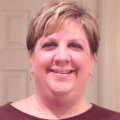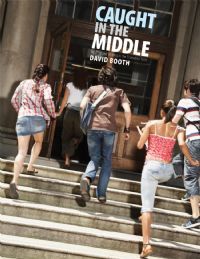Reaching and Teaching ELA Students in Middle School
Caught in the Middle: Reading and Writing in the Transition Years
By David Booth
(Stenhouse/Pembrooke Publishers, 2011 – Learn more)

In his book Caught in the Middle: Reading and Writing in the Transition Years, David Booth has put together an extraordinary collection of resources for those of us who teach Language Arts to middle schoolers.
This fully revised second edition offers a comprehensive look at the middle school experience – who our students really are – while weaving the essential Language Arts skills of writing, reading, and critical thinking throughout. Caught in the Middle is one of those rare books that truly has the capacity to help a teacher carve out a roadmap for a successful year of working with middle school readers and writers.
Getting good
In the preface to the book, Booth remembers a question he was once asked by a teacher: “How do you get to be good?” His answer was both simple and challenging: “Hang around good people.”
And this book offers every teacher who reads it the chance to vicariously hang around some really good people who have walked and talked and lived the rewarding challenge of working with middle schoolers who are growing as readers and writers.
Caught in the Middle provides a comprehensive glimpse into what it means to teach Language Arts (a truly complex web of interdependent skills) to middle grades students (a truly complex and diverse blend of learners). Booth deftly weaves these things together: addressing the varied needs and abilities of our middle school students while providing a plethora of lesson ideas that will engage even the most reluctant readers and writers.
Relationship precedes learning
One of the key foundations to this book’s premise is that relationship is at the core of classrooms with engaged learners. Successful classrooms grow from teachers who create an environment that provides a safe place to learn. Booth states:
When accompanied by effective social and emotional learning that creates a safe space where all participants are respected, student voice increases student engagement and promotes a willingness to take part in classroom activities or school activities as a whole. This welcoming atmosphere is especially important when dealing with the relatively sensitive issues that powerful and relevant texts tend to elicit.
Students may not feel that they can move on to discuss their thoughts and feelings, or to question texts, until trust in the relationship with the teacher has been built and a welcoming climate created. Building a sense of membership in a community helps students overcome anxiety and gain positive self-efficacy; it also enhances learning and understanding.”

One of the many wonderful things about Caught in the Middle is that it’s not filled with platitudes; when the author suggests something like differentiating our lessons, he then backs that suggestion up with real ideas that work in middle school classrooms. This book is in many ways a handbook that can be referred to frequently, full of tips and tricks and ways to create a classroom climate that fosters relationships and engaged learners.
ELA tools and techniques
One of the best features of this book is the breadth and depth of material it covers. Beyond the importance of relationships and engaged learners, this book also discusses:
► cooperative vs. collaborative learning
► using the school library effectively
► diverse learners and those with special needs
► rubrics
► authentic, active reading and writing
► book clubs
► integrating e-literacy and digital tools
► writing feedback
► graphic organizers
► blogging and social networking
► teaching students to self-monitor during their reading
► inferring, visualizing, summarizing as they read
► group reading vs. independent reading
► the 5 Cs of writing
Booth covers all of these topics (and so much more!) thoughtfully and in great detail. And one of the best features of the book is the layout of the pages; there are wide margins with plenty of space for making notes beside the relevant material.
Overall, a powerful rich resource
I found this book to be invaluable and already know that I have only scratched the surface of what it has to offer. I highlighted passage after passage and took copious notes for myself to refer to as I work with my students. David Booth has created a powerful, rich resource for any middle school Language Arts teacher, whether brand new or with decades of experience.
Caught in the Middle has quickly become an essential in my professional library and, I believe, should be required reading for every middle school Language Arts teacher.
Jenni Miller is a 6th grade Language Arts teacher at Montevideo Middle School in Penn Laird, Virginia. She will begin her 21st year of teaching there in August and absolutely loves reading and writing with her middle school students every day. She also loves Pinterest and frequently pins for middle school teachers and students alike. She can be found at www.pinterest.com/jmillermms



































